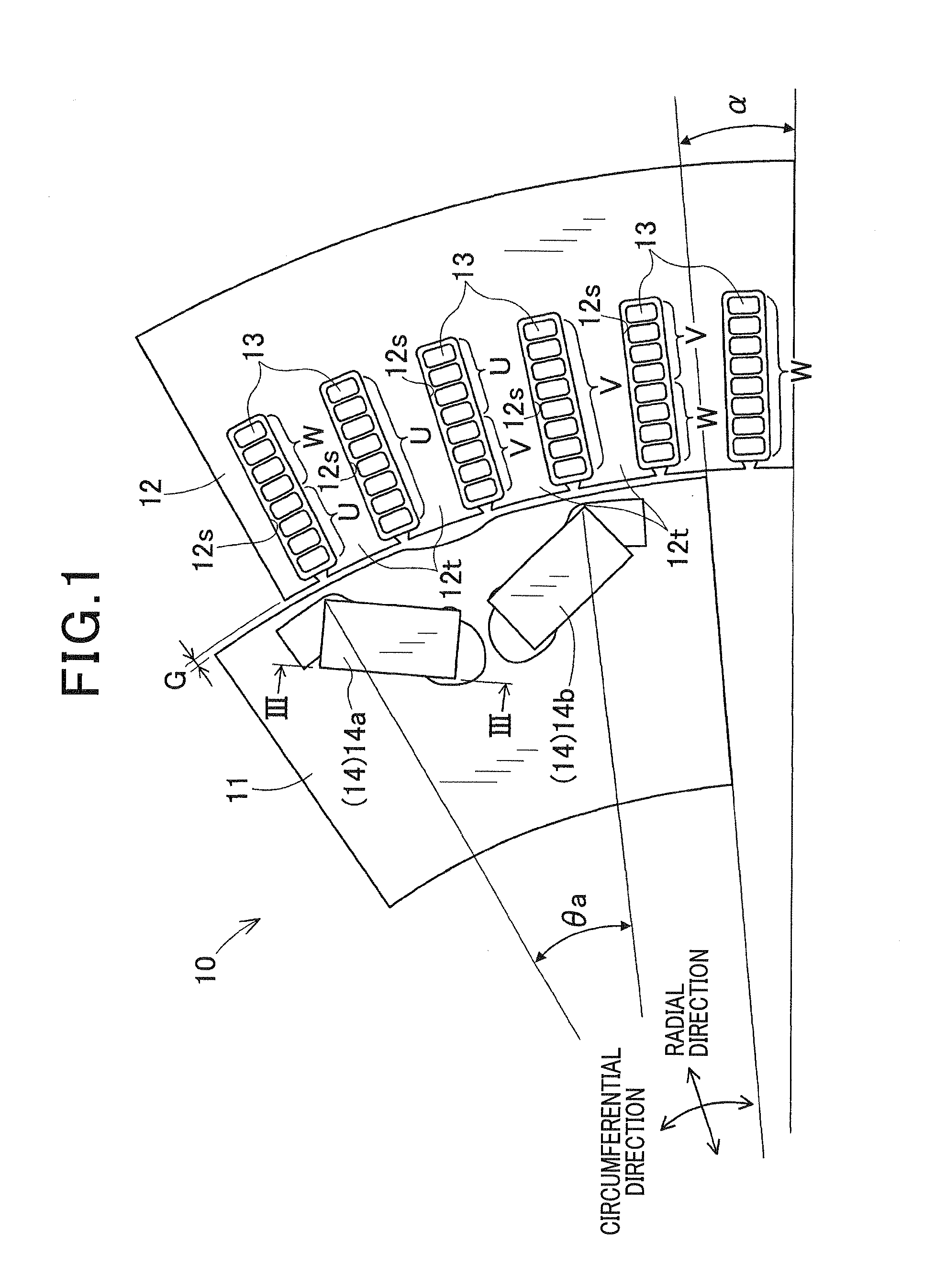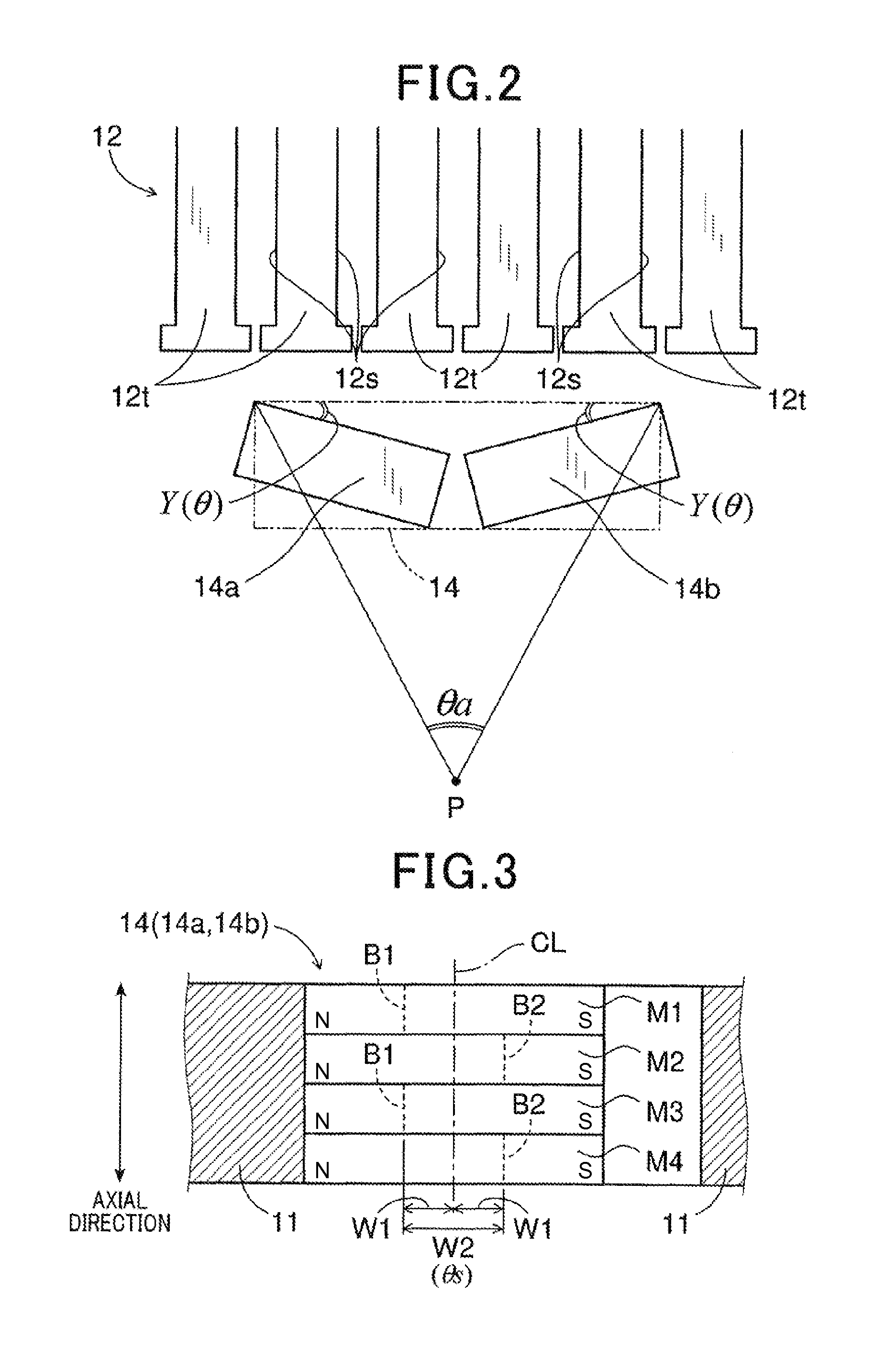Rotary electric machine
a rotary electric machine and electric motor technology, applied in the direction of dynamo-electric machines, magnetic circuit rotating parts, magnetic circuit shapes/forms/construction, etc., can solve the problem of large capacitance or a large body, large harmonic distortion of the back electromotive force (b-emf), and the effect of reducing noise vibration
- Summary
- Abstract
- Description
- Claims
- Application Information
AI Technical Summary
Benefits of technology
Problems solved by technology
Method used
Image
Examples
first exemplary embodiment
[0047]A first exemplary embodiment is described with reference to FIGS. 1 to 18. FIG. 1 shows a part of an overall configuration of a rotary electric machine 10 having a rotor 11 and a stator 12. FIG. 1 is a cross-section diagram, but the hatching is omitted therefrom to make the description easier to understand. In the rotary electric machine 10, the number of phases, the number of pole pairs (i.e., a pair of north and south poles), and the number of slots can be arbitrarily set. In the present embodiment, the rotary electric machine 10 is configured by an inner rotor type in which a rotor 11 is located at the inner diameter side from the stator 12. In this type, the number of phases is three (i.e., U-phase, V-phase and W-phase), the number of pole pairs is 12, and the number of slots is 72.
[0048]The rotor 11 is located in a rotatable manner relative to the stator 12 via a gap G. This rotor 11 is provided with a plurality of magnet sections 14 (for example, 12 magnet sections in th...
first configuration example
[0077]In a case where the magnet section 14 is configured in such a manner that the arc ratio lies in a range of values from 2.2α to 3.3α (i.e, 2.2α≦θa≦3.2α), the skew angle is set to α / 2 (i.e., θs=α / 2). This configuration example satisfies the formula (2) at k=1, i.e, the formula (3).
second configuration example
[0078]In a case where the magnet section 14 is configured in such a manner that the arc ratio is θα=1.65α or θa=1.75Sα≦θa≦2.35Sα if the slot factor is 2 (i.e., S=2), the skew angle is set to Sα / 2 (i.e., θs=Sα / 2). In this embodiment, the slot factor is set to a value of 2 (i.e., S=2), and then, the arc ratio lies in a range of θa=2.2S to 2.3S. Here, if the slot factor is set to a value 3 (i.e., S=3), then the arc ratio lies in a range of θa=1.46S to 1.53S. This configuration example satisfies the formula (2) at k=S, i.e, the formula (4).
[0079]According to the above-described first exemplary embodiment, the following effects can be obtained.
[0080](a) The rotary electric machine 10 is configured by setting the skew angle so as to satisfy:
θs=kα / 2
[0081]where: (i) S is a slot factor which is a ratio of the slots 12s relative to the magnet section 14 (the magnets M1, M2, M3 and M4); (ii) α (deg) is a slot pitch which is an angle between the slots 12s; (iii) θa is an arc ratio which is an a...
PUM
 Login to View More
Login to View More Abstract
Description
Claims
Application Information
 Login to View More
Login to View More - Generate Ideas
- Intellectual Property
- Life Sciences
- Materials
- Tech Scout
- Unparalleled Data Quality
- Higher Quality Content
- 60% Fewer Hallucinations
Browse by: Latest US Patents, China's latest patents, Technical Efficacy Thesaurus, Application Domain, Technology Topic, Popular Technical Reports.
© 2025 PatSnap. All rights reserved.Legal|Privacy policy|Modern Slavery Act Transparency Statement|Sitemap|About US| Contact US: help@patsnap.com



